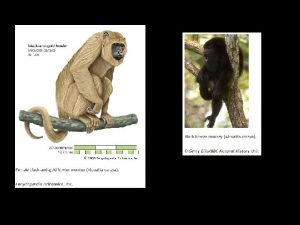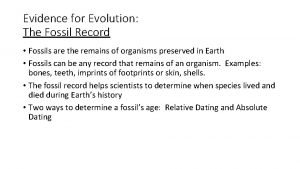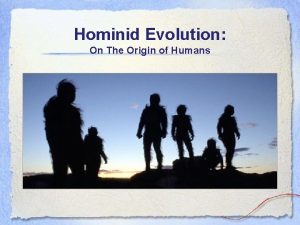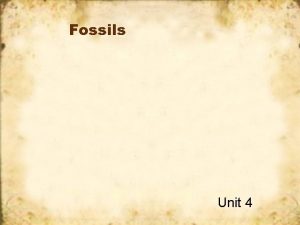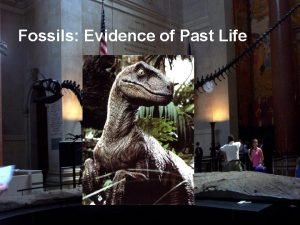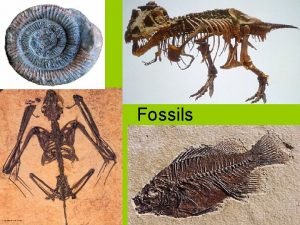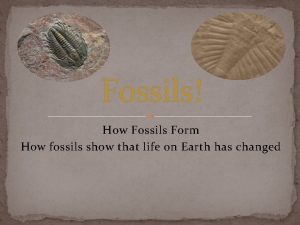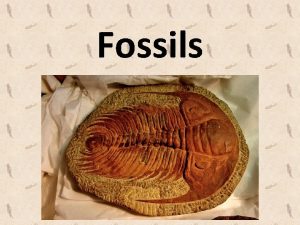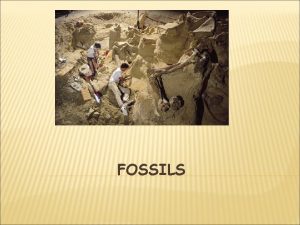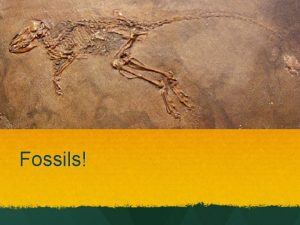Hominid Evolution in Context Ancient hominid fossils not












- Slides: 12

Hominid Evolution in Context • Ancient hominid fossils not accepted as ancestors – Biases in fossil record (from 19 th century): • Fossil remains of species not that old (Homo erectus & Neanderthal) • Found in Asia and Europe • Had relatively large brains – Cultural biases: • • Big brains, intelligence emphasized Resistance to ancestors with primitive features Resistance to Africa as cradle of humankind Humans viewed as unique (culturally & biologically)

Hominid Evolution in Context • Occurs in a series of ADAPTIVE RADIATIONS – The evolution & spreading out of related species into new environmental niches • What “ingredients” are needed for natural selection/evolution to work?

Will the Earliest Hominid Please Stand Up? • Earliest representatives of our lineage lived at end of Miocene & beginning of Pliocene epoch • 6 – 4. 5 mya

Geological Context of Hominid Sites East African Sites • Volcanic ash/sediments • Can be dated by Argon/Argon (chronometric) dating, relative dating techniques (stratigraphy) & paleomagnetism South African Sites • Mostly limestone (no volcanic sediments) • Cave sites with bone accumulations • Dated with biostratigraphy & paleomagnetism

First Adaptive Radiation • Late Miocene (6 -7 mya) • Produces potential/possible LAST COMMON ANCESTORS • These are the earliest (possible) Hominids • Forest adapted

Sahelanthropus tchadensis • Found in central Africa, country of Chad • 7 myo • Nearly complete cranium – Mix of human & ape-like traits – Small braincase: 370 -380 cc – Massively built, heavy browridges, crest in back, large muscle attachments – Reduced upper canine – Small, vertical face • Cannot determine bipedality • OLDEST possible hominid • Common ancestor?

Orrorin tugenensis aka “Millenium Man” • • • Discovered: 2001 in western Kenya Age range: 6 mya Remains: Fragmentary arm & thigh bones; lower jaws & teeth Features: Limb bones larger than later hominid species Cranial capacity: Not yet determined

Orrorin tugenensis, cont. • Notes: Some evidence of bipedality & tree climbing; dental & some skeletal features more human than ape like • Significance: More evidence that bipedalism may have originated in the trees

Second Adaptive Radiation • • • Early Pliocene (4 -5 mya) New species & new genus evolves Dense forest environment All exhibit bipedalism – established hominids Represent a challenge to the established “Savanna Hypothesis”

Ardipithecus ramidus • Discovered: 1994 in Ethiopia by various research teams • Age range: 5. 8 - 4. 4 mya • Features: most complete ancient hominid skeleton – bones of hand, feet, limbs, pelvis, most of skull & teeth; remains of males, females, juveniles

A. ramidus, cont. • Ape-like traits – Grasping big toe (only biped w/ this feature) – Long arms, short legs – Small brain • Human-like traits: – Small canines – Small molars – Hand bones NOT adapted for knuckle-walking

Ardipithecus ramidus • Diet: omnivorous - plants, fruits, insects, nuts, seeds • Environment: lush woodlands, forests • Significance: – 1 my older than Lucy – Closest established hominid to Last Common Ancestor with chimps – Arboreal AND Bipedal Adaptations
 Human evolution
Human evolution Martin puryear cfao
Martin puryear cfao Horse evolution fossils
Horse evolution fossils How is the fossil record evidence for evolution
How is the fossil record evidence for evolution Vocabulary workshop level d unit 1
Vocabulary workshop level d unit 1 High context vs low context culture ppt
High context vs low context culture ppt High context vs low context culture ppt
High context vs low context culture ppt Constancy under negation
Constancy under negation Contoh low context culture
Contoh low context culture Ancient means of communication pictures
Ancient means of communication pictures Ancient india vs ancient china
Ancient india vs ancient china The road not taken bridging
The road not taken bridging Netflix culture seeking excellence
Netflix culture seeking excellence
